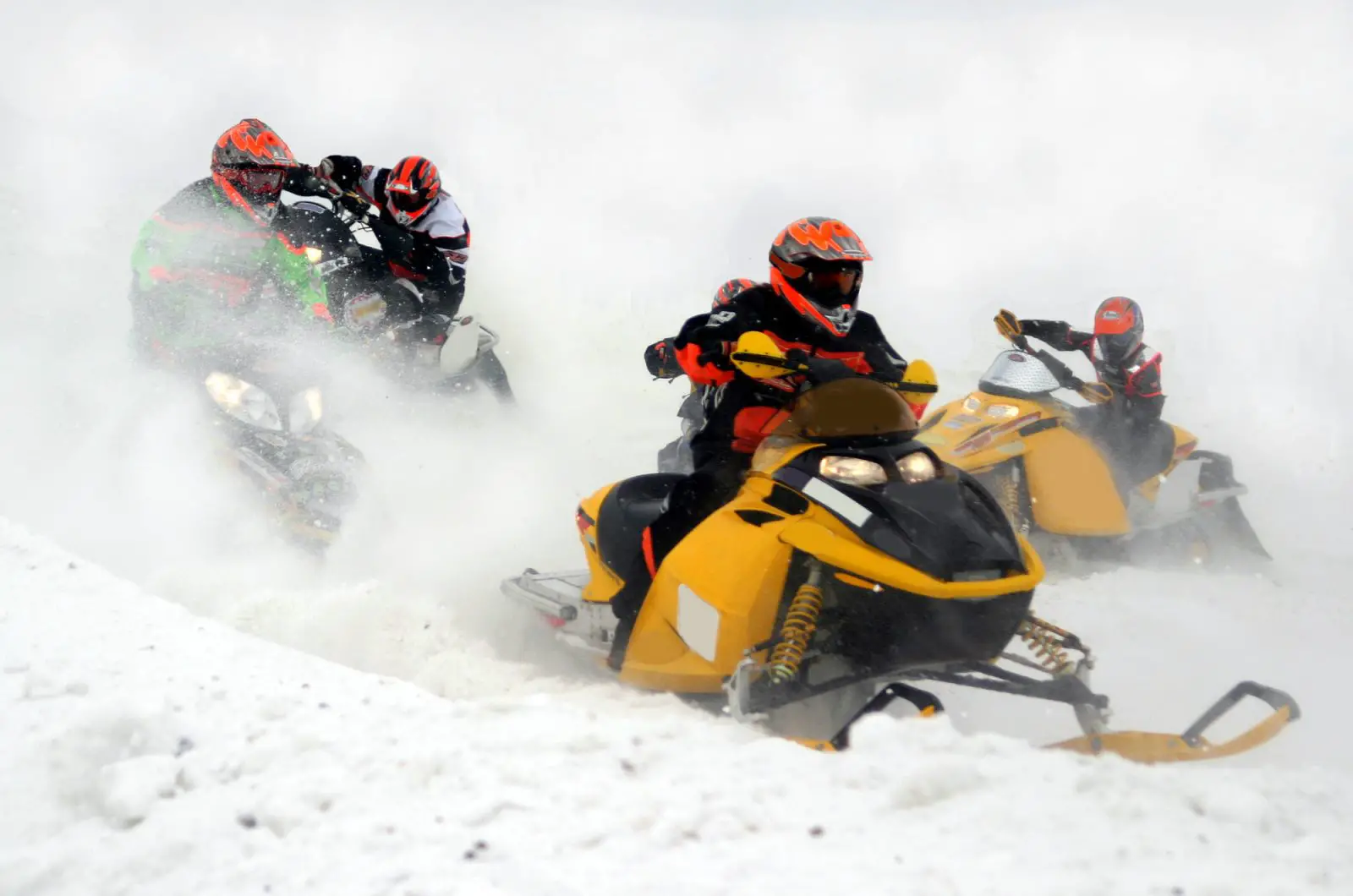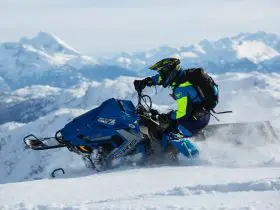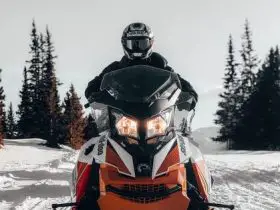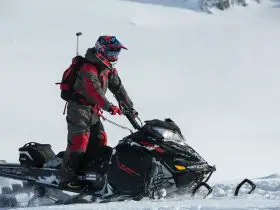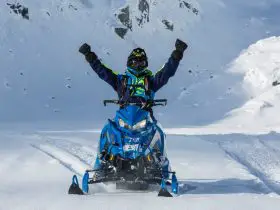More than 50,000 snowmobiles sell across Canada each year.
The history of the snowmobile is as turbulent and thrilling as the sport itself.
Born out of environmental conditions and the problems deep snow poses to postal services and in medical emergencies, it has grown to become a bustling industry. And a cutthroat one too.
Almost all of the snowmobile manufacturers of the golden era are gone. Most are now made by a select few household brands.
And while Canadian-made snowmobiles are now the exception, not the norm, the enterprise was invented in Canada and has been shaped by Canadian firms.
Table of Contents
Canadian Made Snowmobiles
Canada has a rich history of inventing and designing snowmobiles for recreational and professional uses. In the present day, the major manufacturers in the snowmobile industry are:
- Bombardier Recreational Products, inventors of the snowmobile
- Taiga Motors, inventors of the electric snowmobile
- AD Boivin, parts manufacturer
- Dew Engineering, government subcontractor for military-grade equipment
Bombardier Recreational Products
Based in Valcourt, Quebec, BRP is one of the biggest manufacturers in North America, and the largest manufacturer of Canadian snowmobiles.
And with the progenitor of the snowmobile as their founder, they’re the oldest player in the game. Joseph-Armand Bombardier invented the first snowmobile in 1937 – a necessity in Canada’s wintry climate.
BRP was founded shortly after, in 1942. Their initial product, the B12, resembled a small school bus on half-tracks. Bombardier produces more than 3,000 units – mainly for use by postal and emergency services.
By 1960, Bombardier’s success in the market they created had established fierce competition. The B12 and following models performed poorly in deep snow, which opened up the door for competition and the invention of the snowcat.
In spite of the competition, Bombardier has always remained a strong player in the game. They innovate and iterate on the technology constantly, going from strength to strength year-on-year:
In 2020, the manufacturer generated over $6 billion in sales, an increase of 15% over 2019.
Ski-Doo
Bombardier owns several brands and has branched into many industries. Ski-Doo is a subsidiary of BRP that is its best known (but not only) brand of snowmobiles.
Ski-Doo’s brand is all about ruggedness and reliability. Their snowmobiles are renowned for their longevity, making them one of the most popular brands in the world.
The Ski-Doo Renegade series are some of their most popular models, featuring 2 and 4-stroke, 2-cylinder horizontal in-line engines.
On top of an impressive array of snowmobiles, Ski-Doo sells snowmobiling accessories and gear to complement its selection.
Fun Fact: Ski-Doo’s name was originally intended to be “Ski-Dog”, referencing the replacement of dog sleds. But a typo created the name – and it stuck.
Lynx Snowmobiles
Lynx is another brand owned by BRP headquartered in Finland, featuring a similar line of models. Their models are based on the designs of Ski-Doo, but with one major difference.
It’s in the rear suspension system.
Partly inspired by Finland’s rougher terrain, the suspension used by Lynx vehicles is tougher and adapted for harder collisions and more unpredictable terrain.
Taiga Motors
Based in Montreal, Taiga motors is one of the newest additions to the industry. Founded in 2015, the company followed the footsteps of Tesla and the hype around the future of electric vehicles.
Its founding team of engineers had one goal: to design a marketable electric snowmobile. They did just that in 2019, and theirs was the first electric vehicle to enter the market.
Naturally, Taiga is a manufacturer that’s still in its infancy. While they’re known as a growing and innovative brand, only the test of time can tell if they’ll be successful.
And the electric vehicle market in snowmobiling has a unique challenge to overcome: recharging stations. Cars are used on roads, and charging stations have sprung up all over the US road network.
But snowmobiles?
They’re designed for use in harsh, desolate, isolated areas. The range is the biggest challenge for a snowmobile manufacturer because running out of juice leaves you stranded in an icy tundra.
The TS2 initially had a slated range of 60 miles on even terrain. But their latest model, the Atlas, has improved on that, with an estimated range of up to 85 miles.
AD Boivin
Situated in Quebec, AD Boivin was founded in 1995. Initially, the company manufactured heavy-duty suspension systems and other complex parts.
But in 2001, Boivin entered the snowmobile market for real with the Snow Hawk. Purpose-built for snow (only), the company managed to ship more than 1,000 units worldwide before its acquisition by Moto MST in 2011.
The Snow Hawk, sometimes referred to as a Snow Bike, resembles a dirt bike that you’d use on a snowy mountaintop.
It was an innovation in the industry that has since inspired designs like the Arctic Cat SVX 450 (which has since been discontinued). Unfortunately, the Snow Hawk wasn’t without its share of design flaws.
With a poor power-to-weight ratio and subpar suspension, it had difficulty contending with the giants of the industry. And when the recession hit in 2008, AD Boivin began the move to sell its Snow Hawk division and focus on what it does best: designing middleware parts for the big dogs.
Dew Engineering
The final entry on our list of Canadian snowmobiles, Dew Engineering is a company that designs and produces equipment for the Canadian military.
Most of what they do isn’t around snowmobiles. But one of their latest creations – the D900 – is a heavy-duty, military-grade snowmobile designed for serious work.
With a range of more than 300 miles and towing capability of up to 880lbs, it’s a powerhouse
Historic Brands
Around the start of the 1960s, there were a dozen snowmobile manufacturers across the world. By the 1970s, the industry exploded in a boom of competition and innovation.
But what goes up must come down. And a combination of environmental factors and market squeeze crushed many brands.
Club 1977
At one point in history, there were more than 200 brands. And in Canada, snowmobiles have their perfect target market. Many historic companies – even American ones – based their snowmobile products out of Canada.
Most snowmobile enthusiasts have heard of at least some of the big, surviving brands. Yet for many firms in Canada, the snowmobile industry proved too hot to handle.
Why?
The crunch of competition, the oil crisis of the ’70s, and poor snow conditions at the time led to the death of many beloved brands. And many of those brands went under the snowmobile curse: 1977.
And even though they’re no longer in operation, many of them were Canadian companies – and many made significant contributions to the industry.
Boa-Ski
Established in 1967, Quebec-based firm Boa-Ski saw a decade of economic success until its demise in 1977. They sold a variety of models from 1968 onwards.
Some initial success saw Boa-Ski’s assembly line produce more than 40,000 units per year from 1971 onwards, with 350 factory workers.
Boa-Ski did not survive the purge of the late 1970s. In 1972, the company was sold to Alsport. It was sold again in late 1976 to J&B Manufacturing. In 1977, it filed for bankruptcy and became a part of history.
Sno-Jet
Founded by Maurice Fillion and Paul-Émile Roy in 1964, Sno-Jet was up and running by the following year. Like Boa-Ski, the company scaled quickly and was soon selling thousands of snowmobiles each year.
By 1968, the owners had grown tired of the business. Overwhelmed with demand, the owners sold the company to the Glastron Boat Company, a subsidiary of a Texas-based company.
And, like Boa-Ski, the oil crisis of the early ’70s hit hard. Declining sales and a competitive saw the brand bought out by Kawasaki in 1977.
Massey Ferguson
Like John Deere and Ariens, Ferguson is an agricultural powerhouse that once sold snowmobiles. Massey Ferguson was the largest manufacturer of the 1970s, and it made sense to branch out into the snowmobile industry.
And as a maker of farming equipment, they did their best to appeal to farmers. The Ski-Whiz was a tractor-like snowmobile intended for this market.
The company never understood snowmobiling, and the Ski-Whiz didn’t make the grade.
Minnesota-based company Scorpion Inc. took over sled manufacture from 1975, slapping Ferguson’s name on existing Scorpion models. The license ran out two years later – in 1977 – and wasn’t renewed.
Sno-Prince
Lionel Industries, based out of Princeville Quebec, had a short run in the snowmobile industry before the crash.
The Sno-Prince models sold poorly. In 1970-1971, a failed children’s line of snowmobiles was the final nail in the coffin. The company sank in 1973, following the OPEC oil crisis. Its demise would be a sign of bad things to come.
Canadian Made Snowmobiles
There’s no avoiding the truth: Canadian-made snowmobiles shaped the industry and made history. They innovated, they invented, and many went the unfortunate way of the dodo.
But if the recent technological leaps made by Taiga are anything to go by, the Canadian snowmobile is still at the front of the arms race.
And Canadian snowmobiles are still some of the best.
If you want to know more about American-made snowmobiles, we’ve already put together everything you need to know.

